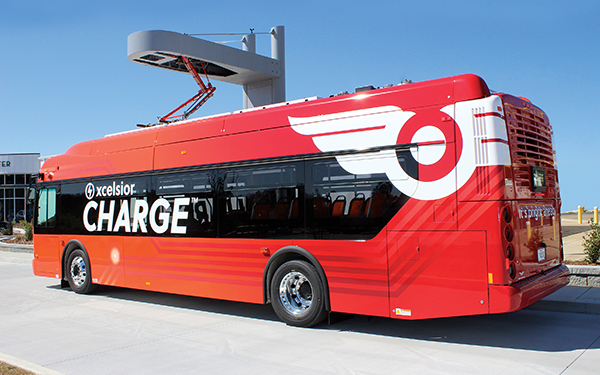
Building Livable Cities
Through Connected Collaboration
By Lindy Norris, New Flyer of America
Simply put, “livability” is the element of a community that makes people want to live there. It is the result of several factors that add up to create a community’s quality of life.
Smart Mobility: Creating livable cities
In 2017, American Public Transportation Association (APTA) Chair Nat Ford identified five priority areas, one of which called out the need for multi-faceted approaches on how to move Americans: a new mobility program. Indeed, Ford is one of several leading the conversation on the need for connected multi-modal infrastructure (or “Smart Mobility”), as the population continues to increase and urbanize.
The statistics alone lend staggering clarity on why Smart Mobility is required to support livable communities:
•By 2030, the world is projected to have 41 mega-cities with more than 10 million inhabitants.
•More than 82 percent of people live in urbanized areas in North America.
•Americans spend 14.5 million hours every day stuck in traffic, and, since 1970:
> The U.S. population has grown by 32 percent,
>The number of registered vehicles has grown by 90 percent,
>The number of vehicle miles traveled has grown by 131 percent, but
>Since then, the total number of road miles grew by only 6 percent.
Little room exists to accommodate any additional cars or time spent on the road, and this reality imposes the need for stakeholders to work collaboratively in creating solutions for seamless mass transportation connected and powered by real-time data.
A “livable” city is one where people want to live, and part of this is connected, multi-modal mobility solutions. This is why New Flyer is committed to Smart Mobility – supporting development of Smart Cities through advanced transit solutions.
It’s also why New Flyer is the first bus manufacturer in the world to support the Shared Mobility Principles for Livable Cities.
The Principles, launched at the 2017 Ecomobility World Festival in Kaohsiung, Taiwan, include ten commitments made by stakeholders in sustainable, efficient, and collaborative mobility development:
1. We plan our cities and their mobility together.
2. We prioritize people over vehicles.
3. We support the shared and efficient use of vehicles, lanes, curbs, and land.
4. We engage with stakeholders.
5. We promote equity.
6. We lead the transition towards a zero-emission future
and renewable energy.
7. We support fair user fees across all modes.
8. We aim for public benefits via open data.
9. We work towards integration and seamless connectivity.
10. We support that autonomous vehicles in dense urban areas should be operated only in shared fleets.
Since launching, C40 Cities, Transportation for America, Uber and Zipcar have joined as “Signatories” – and the growing roster reflects industry leaders with a common interest of developing Smart Mobility around the globe.
Smart Infrastructure across North America
Momentum for smart city development is building, and North American stakeholders have jumped on board in an effort to tackle urbanization.
In February 2018, leaders from the Department of Homeland Security (DHS), Congress, Senate, The White House and other agencies converged for the first Smart Regions Congress, and officially formed the Congressional Smart Cities Caucus. Together, they discussed connectivity in urban, suburban, and rural cores; smart infrastructure and mobility (connected and autonomous transportation); cybersecurity; energy and sustainability.
They also announced the 2018 Smart Infrastructure Challenge, aiming to “empower cities, councils, and government agencies to work together in putting forth innovative plans that reflect residential needs and improve connected infrastructure and transportation in their city or region”.
With interoperability, everyone wins
With a growing interest in Smart Mobility paired with electrification of public transit, dialogue has been building for interoperable vehicles and charging infrastructure (“interoperability”).
The use of common charging standards by bus manufacturers and charging equipment suppliers:
• Reduces the likelihood of charging equipment becoming obsolete, leaving transit agencies with stranded assets,
• Requires less upfront and ongoing cost, by using a collaborative approach for developing enhancements to ensure forward and backward compatibility,
• Simplifies operations in terms of preventative maintenance, service, and parts, and
• Supports intelligent smart charging systems designed to reduce energy costs.
New Flyer has actively promoted interoperability where multiple stakeholders are involved, including bus OEMs, Transit Agencies, the Federal Transit Administration, APTA, the Society of Automotive Engineers, Electric Power Research Institute (EPRI), and non-profit organizations including the Center for Transportation and the Environment and CALSTART. By working together, we improve efficiency of new and evolving transportation infrastructure, and directly impact the ability to develop Smart Mobility in the face of cities with sights set on greater livability.
Together, we can build our connected future
It is clear all stakeholders have woken up to the reality of urbanization, and the need to leverage Smart Mobility in the pursuit of livable communities – their commitment to participation is clear.
This collaboration is no trend: it’s the new, critical reality that will shape our future and power the development of Smart Cities.
For information on the Smart Infrastructure Challenge visit https://www.smartregions.org/blog/5-things-you-need-to-know-about-the-2018-smart-infrastructure-challenge.
For more information on the Shared Mobility Principles, visit https://www.sharedmobilityprinciples.org/.
Lindy Norris is the director of marketing communications for New Flyer.
Visit www.newflyer.com.
